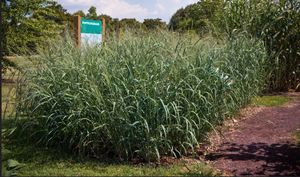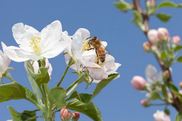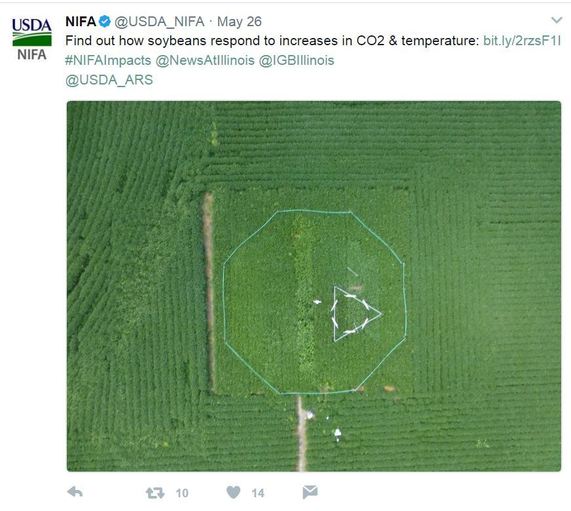|
|
|
Fresh from the Field is a weekly album showcasing transformative impacts made by grantees funded by the National Institute of Food and Agriculture.
June 1, 2017
|
|
Success Stories
 Reclaiming strip mine
fields for biofuel crop production
Strip mines are so common
in rural Pennsylvania that many people are unfazed by the sight of rock-filled
piles of dirt and tracts of barren land.
"In Pennsylvania,
there are hundreds of thousands of acres that have not been reclaimed after
strip mining," said Marvin Hall, professor of forage management at Pennsylvania
State University. "If we show that land can be highly productive after
mining, then maybe we'll see fewer abandoned strip mines and more grassy
fields."
With NIFA funding from the
Northeast Woody/Warm-season Bioenergy Consortium (NEWBio), researchers saw that switchgrass shows promise in reclaiming
strip mine fields. It's a hardy, deep-rooted, perennial grass that's known for
its ability to grow despite poor soil quality, drought, or flood. Switchgrass
has many environmental and commercial benefits, such as providing shelter and
food for wildlife, soil conservation, livestock feed, animal bedding, mulch,
and landscaping.
Switchgrass also has the
potential to serve as a renewable energy source — its biomass can be condensed
into fuel pellets for heating, and it also can be used to make ethanol, an
alternative to gasoline.
Read
more about PSU research on strip
mine field reclamation.
|
 Bees and trees
A University of
Kentucky (UK) entomology doctoral student, Bernadette Mach, has developed a
list of bee-friendly trees and shrubs for the Ohio Valley region. The list can
help homeowners find the right plants for their yards to help conserve bees. In
the past 10 years, researchers estimate that pollinator populations have
declined between 30 and 60 percent, depending on the pollinator. While much of
the attention has focused on dwindling honeybee populations due to colony
collapse disorder, native bee populations including bumblebees, mason bees, and
many other solitary bee species, are also on the decline. Mach started her
research project in the summer of 2014. It is the first comprehensive study of
its kind. The project is supported by the National Institute of Food and
Agriculture.
Plants
Bees Like Best is available online.
|
News Coverage
 What's water got to do with it?
Aquaponics is the
combination of aquaculture and hydroponics. In this integrated system, fish waste,
which contains nitrogen, helps feed plants, which in turn clean the water in
the fish tank. These systems are popular due to their sustainability, higher
nutrient retention efficiency, and lower water requirements. With Agriculture and Food Research Initiative (AFRI) funding, researchers at the University of Hawaii
identified that tomato, pak choi, and romaine lettuce were the best plants to
grow for recycling nitrogenous waste from fish tanks.
Read the Hawaii News Now story.
|
 Managing Utah’s pest
problem
Every year, Utah
scientists discover two to three plant diseases that have not been previously
reported in the state. In addition, known diseases in the state move on to new
hosts. Among the newly identified diseases: Candidatus Liberibacter
solanacearum, which infects potatoes, peppers, and tomatoes; potato virus Y
strain NTN; and watermelon mosaic virus on pumpkins, squashes, and gourds.
Another disease, bacterial spot, was introduced on tomatoes and peppers through
contaminated seeds, resulting in yield losses of $4,000 to $6,000 per acre.
Early detection of new diseases allows growers to control the diseases before
they spread further. Utah State University Extension includes
entomologists and plant pathologists who serve the communities by addressing various
plant and pest issues. The Utah Plant Pest Diagnostic Lab (UPPDL) serves on the Utah School Integrated Pest Management (IPM) Coalition
and provides IPM training to public health employees and public, private, and
charter school faculty and staff.
Learn
more about Utah
plant pest programs.
|
Video
 Alaska creates safer homes
Radon
is a cancer-causing, colorless, odorless, radioactive gas that is present in
Alaska, particularly in the interior uplands. University of Alaska Fairbanks Cooperative Extension Service agents
offered more than 20 workshops in seven communities to address radon
prevention, testing, and mitigation to 400 residents. Extension agents also
tested 15 schools for radon, finding one classroom that had contamination
levels high enough to require remediation.
View the radon safety video.
|
Tweet of the Week
#NIFAIMPACTS

|
|

For more NIFA Impacts, visit nifa.usda.gov/impacts or the Land-Grant University Impacts website. Send us your NIFA-funded impacts at impactstories@nifa.usda.gov or share them on Twitter @USDA_NIFA, #NIFAimpacts.
NIFA invests in and advances agricultural research, education, and extension and promotes transformative discoveries that solve societal challenges.
Fresh from the Field is a weekly compendium of news and information that may be of interest to land-grant and non-land-grant universities, NIFA stakeholders, and other subscribers.
Editor: Falita Liles, Co Editor: Carlos Harris
|
|
|
|